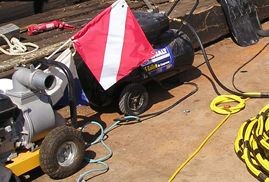Compressors, Engines, and Pumps
When working with compressors, engines, and pumps:

Air compressor used for platform diving operations.
- The equipment may start automatically, without warning. Personnel should stay away and refrain from leaning on or resting anything against the equipment. Post warning signs on the equipment.
- Some parts of air compressors may become extremely hot during use. Mark these places on the machine to warn workers who may come into accidental contact with it.
- Fit rotating parts of pumps, engines, and other machinery, such as fans, belts, chain drives, and clutches, with machinery guards.
- Do not remove safety guards on compressors except when inspecting, making repairs, lubrication, or making adjustments. Replace these parts immediately.
- Do not perform work until power has been shut off, the machinery properly locked and/or tagged out, and any Work Authorization Permits and/or Isolation Certificates have been issued.
- All compressors, engines, and pumps should have all required safety devices installed as per API RP 14C and manufacturer's recommendations.
Use the following best practices when using breathing air compressors:
- Locate the compressor to prevent entry of contaminated air into the air-supply system.
- Minimize moisture content so that the dew point at 1 atmosphere pressure is 10 degrees Fahrenheit below the ambient temperature.
- To ensure breathing air quality, use only approved in-line air-purifying sorbent beds and filters.
- Tag the compressor with most recent change date and the signature of the supervisor or foreman who performed the change.
- Ensure carbon monoxide level in the breathing air does not exceed 10 ppm.
Knowledge Check Choose the best answer for the question.
7-2. Safety guards on compressors should NOT be removed when _____.
You forgot to answer the question!
